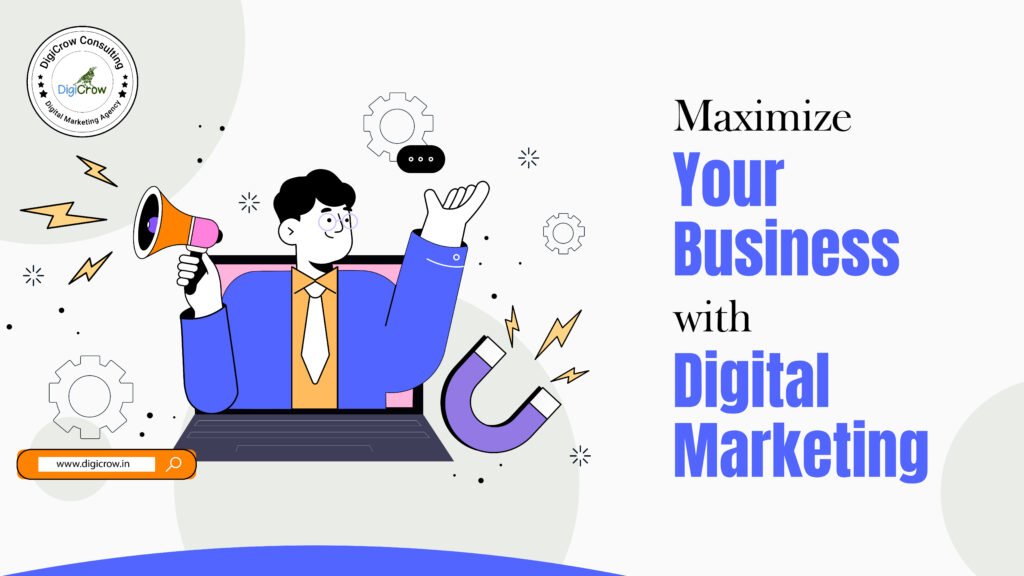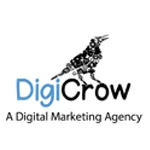Mastering the Digital Realm: An In-Depth Guide to Digital Marketing in 2024
In today’s digital era, the importance of digital marketing is undeniable. DigiCrow, as a front-runner in digital marketing, recognizes the power of online strategies in connecting businesses with their target audiences. This comprehensive guide will delve deep into the facets of digital marketing, underscoring its significance with relevant statistics and exploring various strategies that are crucial for businesses to thrive online.
Table of Contents

In-Depth Guide to Digital Marketing in 2024
Digital marketing refers to the promotion of products or services using digital channels. It encompasses a range of tactics and technologies to connect with customers online. In a world where over 4.5 billion people are internet users, digital marketing is no longer an option but a necessity for businesses seeking to expand their reach and influence.
Inbound Marketing vs. Digital Marketing in 2024:
While often used interchangeably, inbound marketing and digital marketing are distinct. Inbound marketing is about creating and sharing content specifically designed to appeal to your ideal customers, attracting qualified prospects to your business and keeping them coming back for more. Digital marketing, meanwhile, is broader, encompassing all online marketing efforts, both inbound and outbound.
The Importance of Digital Marketing in 2024:
Digital marketing’s importance can’t be overstated. With internet penetration reaching 59% of the global population, it offers unparalleled reach. It’s also more cost-effective than traditional marketing methods, with email marketing alone boasting an ROI of $42 for every $1 spent. Digital marketing enables businesses to interact with their audiences in real-time, offering personalized experiences that can significantly enhance customer satisfaction and retention.
Statistics Highlight:
- 81% of people perform some type of online research before making a large purchase.
- 78% of consumers prefer getting to know a company via articles rather than ads.
B2B vs. B2C Digital Marketing:
B2B digital marketing in 2024 focuses on logical process-driven purchasing decisions, while B2C content is more likely to be emotionally driven. B2B decisions often need content like LinkedIn articles that demonstrate thought leadership, whereas B2C benefits more from social media platforms like Instagram and TikTok, which can showcase a brand’s personality.
Types of Digital Marketing in 2024:
- Content Marketing: This strategy aims to attract and retain audiences by creating and sharing relevant articles, videos, podcasts, and other media. It establishes expertise and promotes brand awareness.
- Social Media Marketing: Platforms like Facebook, Instagram, LinkedIn, and Twitter are used for brand promotion, audience engagement, and driving traffic to websites.
- Pay-Per-Click Marketing: Advertisers pay a fee each time one of their ads is clicked. Google Ads, for example, allows businesses to appear in the sponsored section of search results.
- Affiliate Marketing: A commission-based approach where you earn money for promoting another person’s products.
- Native Advertising: Ads that match the look, feel, and function of the media format in which they appear, like sponsored posts on BuzzFeed.
- Influencer Marketing: Brands collaborate with online influencers to promote products or services.
- Marketing Automation: Software that automates basic marketing operations like email newsletters, social media posting, and campaign tracking.
- Email Marketing: A direct marketing approach involving sending promotional or informational emails to a list of subscribers.
- Mobile Marketing: Engaging with audiences on their mobile devices through tactics like SMS campaigns, mobile app ads, and responsive website design.
Content Marketing:
Content marketing focuses on creating and distributing valuable, relevant, and consistent content to attract and retain a clearly defined audience. It’s about providing value, not just pushing your brand, which in turn, drives profitable customer action. A strong content marketing strategy can boost a company’s performance significantly, with marketers who prioritize blogging efforts being 13x more likely to see positive ROI.
Social Media Marketing:
Social media marketing leverages platforms like Facebook and Instagram to promote a product or service. With over 3.8 billion social media users worldwide, it’s a powerful tool for businesses to increase brand exposure and broaden customer reach. For instance, Instagram boasts over 1 billion active users, making it one of the most popular social networks globally.
Pay-Per-Click Marketing:
Pay-Per-Click (PPC) is an online advertising model in which an advertiser pays a publisher every time their ad link is “clicked” on. It’s a way of buying visits to your site, rather than attempting to “earn” those visits organically. Google Ads is the most popular PPC advertising system, which enables businesses to create ads that appear on Google’s search engine and other Google properties. PPC offers a unique advantage: it gives advertisers an opportunity to put their message in front of an audience that is actively and specifically seeking out their product.
Affiliate Marketing:
Affiliate marketing is the process by which an affiliate earns a commission for marketing another person’s or company’s products. The affiliate simply searches for a product they enjoy, then promotes that product and earns a piece of the profit from each sale they make. Sales are tracked via affiliate links from one website to another. According to Statista, business spending on affiliate marketing will hit $8.2 billion in the U.S by 2022.
Native Advertising:
Native advertising refers to advertisements that are primarily content-led and are featured alongside other, non-paid content. BuzzFeed-sponsored posts are a prime example, but many people also consider social media advertising to be “native” — Facebook advertising and Instagram advertising, for instance. Unlike display ads or banner ads, native ads don’t really look like ads. They look like part of the editorial flow of the page. The key to native advertising is that it is non-disruptive – it exposes the reader to advertising content without sticking out like a sore thumb.
Influencer Marketing:
Influencer marketing involves brands collaborating with online influencers to market one of their products or services. Some influencer marketing collaborations are less tangible than that – brands simply work with influencers to improve brand recognition. An example of this is the partnership between Instagram influencers and the luxury travel destination, The Maldives. Influencers are given free stays in exchange for posts and stories that showcase the resort.
Marketing Automation:
Marketing automation refers to the software that serves to automate your basic marketing operations. Many marketing departments automate repetitive tasks such as email marketing, social media posting, and even ad campaigns — not just for the sake of efficiency, but so they can provide a more personalized experience for their customers. The technology of marketing automation makes these tasks easier.
Email Marketing:
Companies use email marketing as a way of communicating with their audiences. Email is often used to promote content, discounts, and events, as well as to direct people toward the business’s website. The types of emails you might send in an email marketing campaign include: Blog subscription newsletters; Follow-up emails to website visitors who downloaded something; Customer welcome emails; Holiday promotions to loyalty program members; Tips or similar series emails for customer nurturing.
Mobile Marketing:
Mobile marketing reaches target audiences on their smartphones or tablets through email, SMS and MMS, social media, websites, and apps. In a world where more than half of us are accessing the internet via mobile devices, implementing a mobile marketing strategy is no longer optional. It’s a necessity. The rise of mobile commerce (m-commerce) has made it increasingly important for businesses to adopt mobile marketing strategies.
The Benefits of Digital Marketing in 2024:
Digital marketing allows for cost-effective strategies and campaigns that can be tailored to suit the budgetary needs of small and medium-sized enterprises. It provides measurable results, letting you see the exact number of people who have viewed your website’s homepage in real time using digital analytics software. Digital marketing also allows for precise targeting, where ads are presented to customers based on their preferences or initial actions, such as when they like a page, click a link, or watch a video. According to Google, advertisers make $2 in revenue for every $1 they spend in AdWords.
- Creating a Digital Marketing Strategy:
A successful digital marketing strategy involves an in-depth understanding of your business, goals, and audience. It requires identifying your goals, understanding your audience, setting a budget, choosing your channels, creating your content, and analyzing and adapting based on performance data. A good digital marketing strategy should guide your actions and ensure they lead to real business results.
- Refining Your Marketing Efforts:
Digital marketing is not a set-and-forget process. To stay relevant and effective, businesses need to continually analyze the performance of their marketing strategies and refine them. This involves using data and analytics to understand customer behavior, adjusting marketing strategies according to market trends, and continuously optimizing content and methods for better engagement and conversion.
- Digital Marketing and Business Growth:
Digital marketing plays a pivotal role in expanding a business’s reach and increasing its customer base. It drives brand awareness, boosts sales, and enhances customer engagement, contributing to overall business growth. For instance, content marketing costs 62% less than traditional marketing and generates about 3 times as many leads. Digital marketing is an essential tool for brand development, creating lasting relationships with consumers, and driving measurable growth.
As DigiCrow, we specialize in harnessing the power of digital marketing to drive growth and success. Our expertise spans the breadth of digital marketing strategies, enabling us to create bespoke solutions that deliver tangible results.



Pingback: Digital Marketing Campaign at 70th Everest Summit